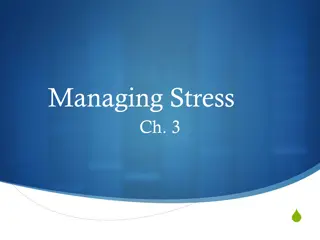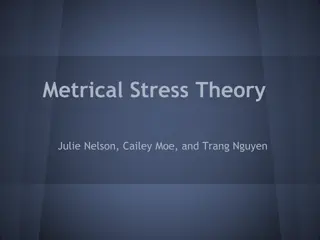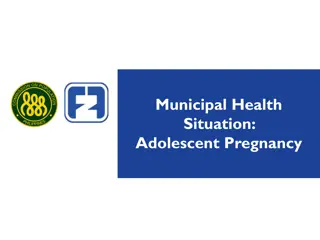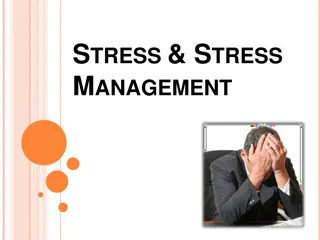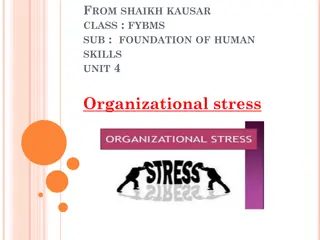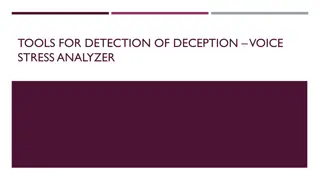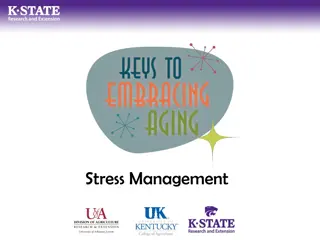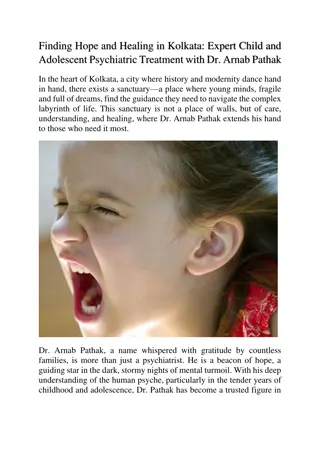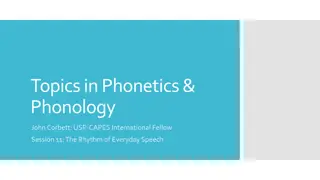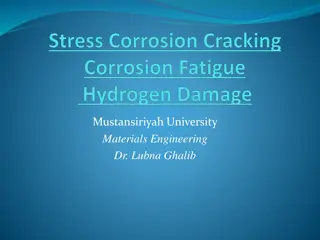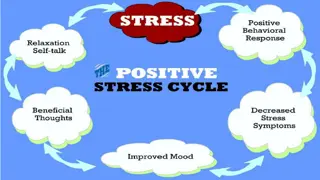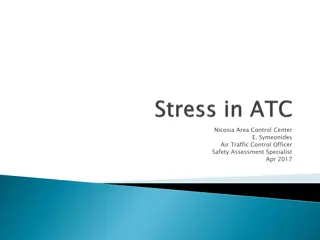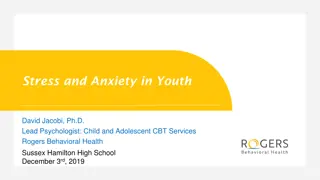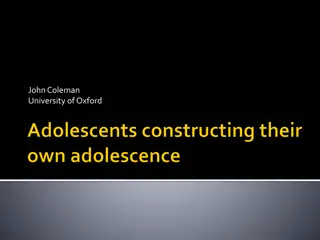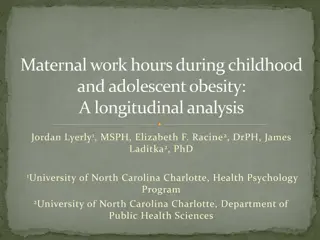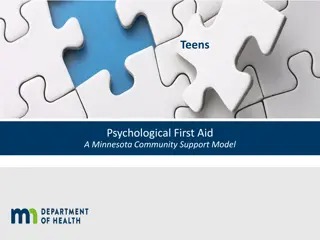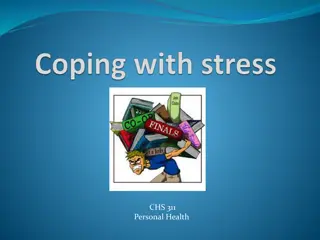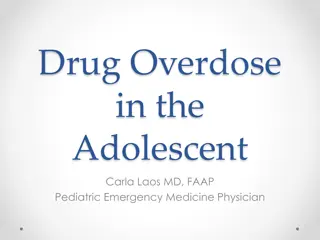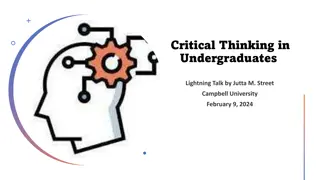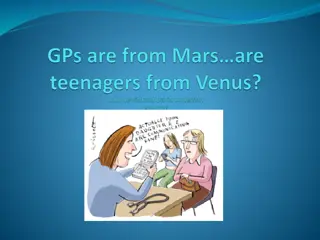Adolescent Stress and Development
Recognize the warning signs of stress in adolescents, such as academic pressure, over-scheduling, mood swings, and poor impulse control. Explore the ups and downs of adolescence, the impact of brain development, and the role of neuroscience in explaining challenging behaviors. Gain insights into the unique challenges faced by teenagers in the modern educational and social environment.
Download Presentation

Please find below an Image/Link to download the presentation.
The content on the website is provided AS IS for your information and personal use only. It may not be sold, licensed, or shared on other websites without obtaining consent from the author. Download presentation by click this link. If you encounter any issues during the download, it is possible that the publisher has removed the file from their server.
E N D
Presentation Transcript
Manifestations of Stress: Recognizing the Warning Signs All-Staff Training Churchill High School October 4, 2010
Montgomery County, MD: Montgomery County is one of the most affluent counties in the US MC-Highest percentage(29.2%) of residents over 25 who hold post-graduate degrees Parents expect their children to be the best Parents want to give their kids what they did not have Take as many as AP classes so you can so that you get into good college.
Churchill High School 98.6% graduates attend college Many are over-scheduled with extra- curriculum activities: (art, music, athletics, clubs, theatre, journalism.) Their talents are extremely impressive Some kids bite off more than they can chew >Academic stress is off the charts >Increasing % of school avoidance/refusal
The UPs and DOWNs of Adolescence *Body Changes: Puberty Raging hormones/New sexual desires Separation/Individuation from Parents Schools /Friends Change *Mood Changes: It is normal for teen to feel moody, confused, defiant, and reckless as they break rules, test limits, and take risks >identity formation
Poor Impulse Control Teen s judgment can be overwhelmed by the urge for new experiences, thrill seeking, and sexual and aggressive impulses. Seem driven to seek experiences that produce strong feelings and sensations. In real life, adolescents compared to adults, find it more difficult to: interrupt an action under way (stop speeding); to think before acting Choose between safer and riskier alternatives.
Neuroscience Explains the WHY * Accidental deaths, homicides, and binge drinking spike in adolescence. It s when psychosis, eating disorders, and addictions take hold. Surveys show that everyday unhappiness reaches its peak in late adolescence. Scientific research reveals how teens unsettled moods and unsettling behavior is rooted in uneven brain development. [Harvard Mental Health Letter]
Brain Development It s not a question of intellectual maturity Studies show that by ages 15 or 16, a teen has abstract reasoning, memory, and formal capacity for planning. They can give the same answers as adults when asked hypothetical questions about reward and consequences. Yet, in real life, adolescents compared to adults, find it more difficult to interrupt an action under way (stop speeding.)
Prefrontal Cortex and the Amygdala Not mature until 20 s, last connections are prefrontal cortex (which is seat of judgment and problem solving) with the emotional centers in the limbic system, especially the amygdala. These links are critical for emotional learning and high-level self-regulation.
The Power of Group Teens find themselves by identifying with a peer group Teens make more risky decisions when friends were watching. This dynamic is present in gang violence, reckless driving and drinking that occurs in groups due to group peer pressure. Power in numbers ..
Challenges At-Risk Teens Face Anxiety School Avoidance Dropping Grades Medical Illness Pregnancy/STDs, HIV Family Problems Unemployed Parent Separation/Divorce Peer Pressure Eating Disorder Substance Abuse Sexual Orientation Cyber-Bullying Crime/Violence Accidents Running away/sneaking out of house Depression Self Injury Suicide
2009 Study-Journal of Pain 382 high school students grades 8-12, mean age 14.4 yrs (223 female and 159 male) filled in questionnaires Insecure adolescents feel more intense pain, and are more likely to be anxious, depressed, and to catastrophize. They have frequent headaches, stomach pain, and joint pain. 20-25% experience chronic pain
Anxiety in Adolescents *Generalized Anxiety: persistent/excessive worry, fears Worst Case Scenario *Panic Disorder-sweating, pounding heart, difficulty breathing, nausea, stomach pains, dizziness, lightheadedness, feeling faint, fear of losing control, going crazy, dying *Phobia-dread and avoidance of situations *OCD-presence of recurrent, persistent and unwanted thoughts, impulses, or obsessions; >performance of repetitive behaviors: washing, checking, repeating. *PTSD-experiencing a traumatic causing fear, horror, and hopelessness; >recurring flashbacks, dreams,+ startle reaction
Eating Disorders: Anorexia/Bulimia Obsessed with food/calorie intake Withholding/Starving/Binging/Purging Fear of food + fat/inability to stop once started Excessive exercise Avoidance of eating certain foods (i.e. fat) Feels in control by starving/purging Can cause Death/high suicide rate Family history of eating disorders, bipolar, alcohol/drug abuse
Drugs and Alcohol Abuse Many see using as a right of passage. Everyone does it =Peer pressure Using is an instant ticket of acceptance to the using/negative peer group. Substance abuse is a form of anesthesia, a way to not feel the anxiety that accompanies aspects of a teen s life.
Substances: Denial is a Symptom * It s fun. It makes me feel better. If Using Substances causes problems ..? Drugs/ alcohol is a central nervous system depressant > using can cause depression. {Chicken or Egg?} A family history of alcohol /drug use increases the probability for addiction for teen. Studies reveal how early drug use is correlated to ongoing psychiatric conditions that develop later in life.
Adolescent Depression Changes in eating habits (weight loss/gain) Change in sleeping habits Loss of Interest in activities Falling grades Poor concentration Withdrawal from family and friends School refusal Crying/Irritability Chronic boredom Drug/Alcohol abuse Self Injury Self Body Piercing Increased sexual activity Running Away Grief Guilt, shame, self derogatory comments 20% of teens have depression
Adolescent Self Injury Definition-Dr. Armando Favazza: 1987 author of Bodies Under Siege * a deliberate alteration of body tissue without suicidal intent. Daldin(1990): self-injury has aggressive as well as sexual components. 9/23/2024 17
Teachers and Adolescent Self injury Classrooms of today are populated with many teens who, to the untrained eye, may appear to be emotionally healthy. Some of these seemingly well-adjusted students tend to resort to maladaptive self injury. High School Teachers must become more aware of this growing problem.
Assessing Teachers Awareness/Knowledge of S.I. + their Ability to Intervene 2004 Chicago Study seeks to address (a)the level of awareness and knowledge that teachers have about self cutting behavior of adolescent studies and (b) how confident and prepared teachers feel they are to intervene with a student with a self-injuring , on, DeGeer, Deur, and Fenton 150 High School Teachers from 3 suburban Chicago high schools Participants self-administered a questionnaire measuring current knowledge of adolescent self injury
2004 Study Results The majority of the participants did not feel knowledgeable or confident in their ability to respond to self injury. Also, 85% felt that they would benefit from more training
Adolescent Self Injury-[Galley, 2003) It is crucial to be more alert to this behavior and not accept without question flimsy explanations for injuries like: the cat scratched me, or I fell down the stairs. Teachers may be the first to notice symptoms of SI and the first to approach a self injuring student. If teachers, who are on the front line, are made aware of this growing problem, a move towards preventing this epidemic will be made.
Common Forms of Self Injury Cutting: most common Burning Biting Scab picking Head Banging Hair-pulling Scratching Self-hitting Interference with wound healing Carving Breaking Bones (Briere & Gil, 1998; Ross & Heath, 2002) 9/23/2024 22
Where do their body do they self-harm? Arms Legs Wrists Hands Hips Upper thighs Areas within easy reach of dominant hand + easily hidden with clothing
Functions of S.I: Control Distraction: Physical Pain is Better than Emotional Pain Teen is DOING SOMETHING-focusing on healing It proves they are alive Every scar tells a story Usually an attempt to stay alive, not die
Functions continued. Communication Dissociation Punishment Proof that their pain is real Proof of being alive-{Like George Bailey in It s a Wonderful Life } 9/23/2024 25
What are the warning signs of SI? Always wearing long sleeves/pants>even in hot weather Avoiding exposure to body parts Refusal to wear shirtless, shorts, bathing suit, or to undress in front of others Wearing wrist bands. wrist warmers, or sweat shirts with thumb-hole Wearing inches of bracelets to cover wrists New body piercings appearing Frequent accidents Hiding knives, scissors, pins, tacks, box cutters in bedroom, purse, backpack Unexplained bruises/cuts with flimsy excuses
Typical SI Teen Profile Appear to be high performers: A s, ace athlete, actor, dancer, editor of paper, goal oriented Perfectionists: one mistake is UNACCEPTABLE Always FINE, with smile on face Its not OK for teen to NOT BE OK! This student usually is THE LAST person that teacher would have to worry about
Yet, Once Teen is ALONE No matter how many awards won, A s achieved, goals kicked, lead in plays given, field goals kicked, newspapers edited, etc. ..it is NEVER ENOUGH! Teen never feels good enough; because comparing herself with others, she always falls short. Since a picture is worth a thousand words
They Fly Under the Radar They need to hide/deny their pain from adults by literally keeping it under wraps. Always performing, teen has to prove their value every day to the world, needing constant validation. She is only as good as her last A. Getting a B means failure: Black and white thinking (all good/bad) Concrete thinking- Needs to get the bad parts out
Concrete Thinking Primitive Defenses: Splitting: black/white thinking, all good/bad If you don t ask, she won t tell ( I promise to not cut ) Teen doesn t trust self /own emotions Unable to talk about /feel intense emotions Speaks in clipped fashion, answers questions in one word answers (yes/no) Feels empty-no object constancy, needs constant reassurance >YOU feel THEIR emptiness
Making a Proper S.I. Risk Assessment Have you ever in your life hurt yourself on purpose? How old were you? (when, where, what did you use.) Can you tell me about it? Why? What are your triggers? How many times in your life have you hurt yourself on purpose? When was the last time you hurt yourself ? 9/23/2024 31
Adolescent Suicide Suicide: The End Game Many SI Teens flirt with the idea of suicide 3rd leading cause of death Themes of death, dying, hopelessness, and extreme violence can surface in suicidal s teens school work. Homosexual/gay/lesbian/transgender + adopted teens have highest rates of suicide
Assessing for Acute Suicidality Assess for depression, helplessness, hopelessness on a scale from 1-10. Suicidal ideation, plan and intent, implementation and access to a means of suicide, past suicide attempts Family history of suicide, depression, bipolar disorder, alcoholism/drug abuse Recent stressors or losses that are triggers
What Should Teachers Do? This is real, not just a teen being emo. Treat students with respect and dignity Do NOT talk down or in condescending manner Do NOT judge>LISTEN! They don t want to be treated like a baby or with kid gloves Trust your gut feelings Make a referral to school counselor Take this seriously , do not minimize By reaching out and caring, you could be saving a life, yet you might not ever know!
Be Aware of Counter-transference Be aware of your OWN emotional reactions when listening to a student s problems Common negative reactions ( I feel anger, fear, confused, overwhelmed, manipulated. ) Reach out to colleagues, department head, supervisor, counselor specialist for assistance Remember, teens who self injure are bleeding emotionally, , but don t have the ability or words to tell you
Self-Monitoring White et al., 2003 suggested the importance for school counselors to monitor their personal reactions to disclosures of self injury and not make decisions based on transference reactions such as fear or a desire to control the student s behavior. Shame and embarrassment tend to accompany this symptom, thus increasing the need to keep their S.I. hidden & a secret. Avoid displaying shock, engaging in shaming, punitive responses.
Whack-A-Mole Symptoms are addicting but move around Teen replaces s.i. with purging, with pot/cough syprup (ROBO-ing) All are forms of Self Medication A way to Not FEEL PAIN!!! Anesthesia
Colored Bracelets Different colored bracelets make announcements: Purple= pro-Bulimia ( Mia ) Red= pro-Anorexia ( Ana ) Orange=pro-Self-Injury Understand that these bracelets are supporting illnesses that can result in death
Can I Tell You a Secret? If a Kid comes to you and says this . Do NOT ENABLE THEM!!!!!!! Say: It depends on what you tell me. I am here to help you, so I can t keep a secret that would hurt you. If they tell you they are suffering from any form of SI or having suicidal ideation: Thank you for telling me. We are all here to help you. Let s go down to talk to your counselor/school nurse.
Who to Believe.?? A friend of Susie comes to you to express worry about Susie, saying that Susie has been cutting herself and is now having suicidal thoughts. You don t know Susie. Susie gets great grades, always has a smile on her face, and has a lot of friends. When you ask Susie about it, she gets extremely upset, seems to be insulted, and wants to know who ratted on her. Who do you believe? What do you do?
ACCESS To GUNS: Access to GUNS: ALWAYS ask high risk teen and (parents) if the teen has ANY access to guns Tendency to assume that families in opulent Montgomery County do not own guns, so we don t usually ask. Depressed/bipolar teens who have access to guns are at high risk for suicide. The Washington Post 10/2007 study : nearly twice as many people commit suicide in the 15 US states with the highest rates of gunownership than in the 6th states with the lowest rates of gun ownership, although the population of the two groups is about the same. 9/23/2024 41
Barriers to Effective Treatment: Parental Denial My teen is just going through a phase She will grow out of it She just wants attention Just Fix my kid, I m NOT putting her on Medication!!!! . I am letting my daughter stop the sessions because they upset her too much. She s always in a bad mood after. Due to parent s own fears, some will refuse to support the treatment or the use of medication 9/23/2024 42
How Can You Help a Teen Who Doesn t Want Your Help? Create a Safe Environment for this hard to reach, evasive population. If you see unexplained scars, ask open ended questions in a calm and non-judgmental way. What happened? Can you say more about that? What was that like for you? Be an active listener while mirroring their emotions. Role model structure, consistency, and predictability in your counseling relationship.
Barriers: Teen Denial It s not a big deal (I m not worth it) Symptom of SI is ego-syntonic where teen is wedded to it. If it s NOT BROKEN, WHY FIX IT? It s my body, and I m not hurting anybody. [But you are hurting yourself] So what? I don t care BACK-OFF . I DON T NEED HELP!!!
What IS the Definition of SUCCESS? In Even Eagles Need a Push the author interviewed many famous people and asked them if it was their fame or fortune that made them feel successful? They gave a surprising answer: To GIVE BACK to the Community. There are MANY ROADS that LEAD to ROME.
Make a Referral to Counseling Office Adolescent self injury is a CRY FOR HELP Teen is self-medicating when self injuring One episode of self injury is one time too many Know resources for therapist/hospital who specialize in the treatment of adolescent self injury
ASIF WWW.adolescentselfinjuryfoundation. com
ASIF: Website began 2/2010 Over 48,500 hits on the internet since 2/2010 From 5 Countries This data shows how rates of Adolescent SI are rising world-wide.
Spread the Word: How to Help Click on www.adolescentselfinjuryfoundation.com Find ideas for: how to help S.I. teen, your SI friend, first steps for parents to take, lists of alternative behaviors to self injury! GOOD LUCK!



